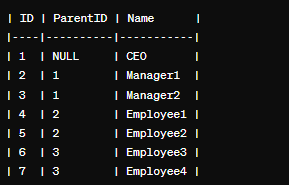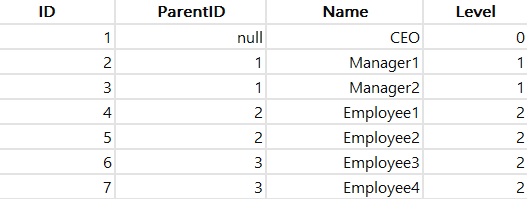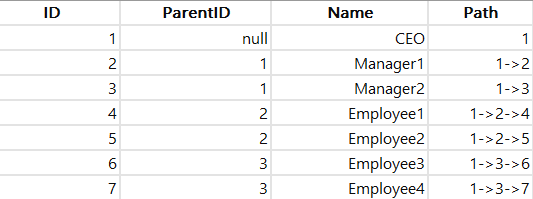How to Run Hierarchical Queries with PostgreSQL?
Last Updated :
12 Mar, 2024
In the area of database management, dealing with hierarchical data structures has unique challenges. Whether it’s organizational charts, category hierarchies, or file systems, efficiently querying and traversing hierarchical data is essential for many applications.
PostgreSQL, a powerful relational database management system, offers robust support for handling hierarchical queries through the use of recursive queries and Common Table Expressions (CTEs). In this article, We will learn about
How to run Hierarchical Queries with PostgreSQL?
Hierarchical queries involve retrieving data that is structured in a tree-like format, where each record has a relationship with other records in the same table. PostgreSQL provides the WITH RECURSIVE clause along with Common Table Expressions (CTEs) to handle hierarchical queries effectively. Below are the approaches to run Hierarchical Queries with PostgreSQL:
- Using UNION ALL Operator
- Using JOIN and LEVEL
- Using Path Concatenation
Let’s set up an environment
To understand How to run Hierarchical Queries with PostgreSQL we need a table on which we will perform various operations and queries. Here we will consider a table called Organization which contains ID, ParentID, and Name as Columns.
-- Create the Organization table
CREATE TABLE Organization (
ID SERIAL PRIMARY KEY,
ParentID INTEGER,
Name TEXT
);
-- Insert sample data
INSERT INTO Organization (ParentID, Name) VALUES
(NULL, 'CEO'),
(1, 'Manager1'),
(1, 'Manager2'),
(2, 'Employee1'),
(2, 'Employee2'),
(3, 'Employee3'),
(3, 'Employee4');
Out table Organization looks below:

table
1. Using UNION ALL Operator
This approach uses the UNION ALL operator to combine the results of the anchor and recursive members within the same CTE. It efficiently traverses the hierarchy.
Example:
WITH RECURSIVE HierarchyCTE AS (
SELECT
ID,
ParentID,
Name,
0 AS Level
FROM
Organization
WHERE
ParentID IS NULL
UNION ALL
SELECT
t.ID,
t.ParentID,
t.Name,
h.Level + 1
FROM
Organization t
JOIN
HierarchyCTE h ON t.ParentID = h.ID
)
SELECT
ID,
ParentID,
Name,
Level
FROM
HierarchyCTE
ORDER BY
Level, ID;
Output:

Recursive Query using UNION ALL Operator
2. Using JOIN and LEVEL
This approach introduces a Level column to keep track of the depth in the hierarchy. It uses the WITH RECURSIVE clause to define the recursive operation.
Example:
WITH RECURSIVE HierarchyCTE AS (
SELECT
ID,
ParentID,
Name,
0 AS Level
FROM
Organization
WHERE
ParentID IS NULL
UNION ALL
SELECT
t.ID,
t.ParentID,
t.Name,
h.Level + 1
FROM
Organization t
JOIN
HierarchyCTE h ON t.ParentID = h.ID
)
SELECT
ID,
ParentID,
Name,
Level
FROM
HierarchyCTE
ORDER BY
Level, ID;
Output:

Recursive Query using JOIN and LEVEL
3. Using Path Concatenation
This approach includes a column for path concatenation, where the path to each node is represented as a concatenated string. It can be useful when you need to track the path or lineage of each node in the hierarchy.
Example:
WITH RECURSIVE HierarchyCTE AS (
SELECT
ID,
ParentID,
Name,
CAST(ID AS TEXT) AS Path
FROM
Organization
WHERE
ParentID IS NULL
UNION ALL
SELECT
t.ID,
t.ParentID,
t.Name,
h.Path || '->' || t.ID
FROM
Organization t
JOIN
HierarchyCTE h ON t.ParentID = h.ID
)
SELECT
ID,
ParentID,
Name,
Path
FROM
HierarchyCTE
ORDER BY
Path;
Output:

Recursive Query using Path Concatenation
Conclusion
Overall, PostgreSQL’s support for hierarchical queries through recursive queries and CTEs provides a powerful tool for querying and traversing hierarchical data structures. By understanding the WITH RECURSIVE clause and the UNION ALL operator, developers can efficiently navigate complex hierarchical data models. Additionally, the ability to use path concatenation and track the depth of the hierarchy adds versatility to PostgreSQL’s hierarchical query capabilities.
Share your thoughts in the comments
Please Login to comment...